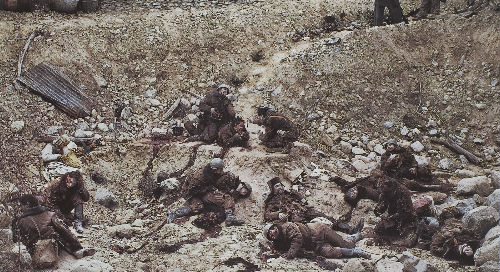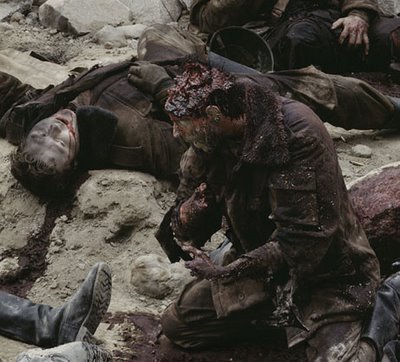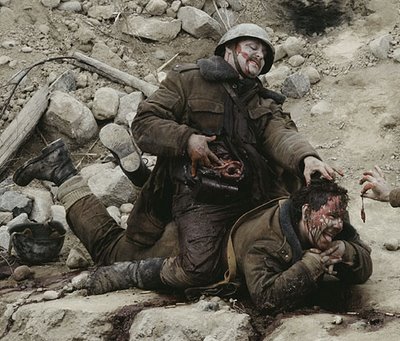 Dead Troops Talk (A vision after an ambush of a Red Army patrol, near Moqor, Afghanistan, winter 1986) 1992, 2290 x 4170 mm,Transparency in lightbox
Dead Troops Talk (A vision after an ambush of a Red Army patrol, near Moqor, Afghanistan, winter 1986) 1992, 2290 x 4170 mm,Transparency in lightboxclick pic to enlarge
In Dead Troops Talk, Wall merges conventions from war and horror movies with those of the history painting of previous eras to create an elaborate, grotesque fiction. The picture presents a hallucinatory scene in which soldiers who have just been killed on the battlefield are re-animated, engaging with each other in what the artist describes as a 'dialogue of the dead'. As the title indicates, the troops are a Soviet patrol ambushed in Afghanistan during the war and occupation of the 1980s. Each figure or group seems to respond differently to the experience of death and reanimation. The three soldiers clowning with their own wounds provide a note of macabre levity. Wall has suggested that their black humour is as plausible a reaction to their circumstances as the more serious or distressed responses of their comrades. As carefully constructed as a film or epic painting, the work was shot in a large temporary studio, involving performers and costume, special effects and make-up professionals. The figures were photographed separately or in small groups and the final image was assembled as a digital montage. 'The young boy, whose head is blown open and has lost his hands, is in a way the central figure, and he is saying something that he feels is urgent to the older captain but because the captain’s dead too, he's also moved into another dimension, one in which he doesn't have to answer. There's no urgency – he's contemplating this boy's questioning nature, or contemplating the urgency itself, who knows.' - Jeff Wall
'The young boy, whose head is blown open and has lost his hands, is in a way the central figure, and he is saying something that he feels is urgent to the older captain but because the captain’s dead too, he's also moved into another dimension, one in which he doesn't have to answer. There's no urgency – he's contemplating this boy's questioning nature, or contemplating the urgency itself, who knows.' - Jeff Wall 'I wanted to involve an element of levity, but without comedy... In any group of thirteen men, three at least are going to be complete fools. So it's likely they would remain fools even after death. On the other hand, maybe they weren't fools before, and only became so once they were killed.' - Jeff Wall
'I wanted to involve an element of levity, but without comedy... In any group of thirteen men, three at least are going to be complete fools. So it's likely they would remain fools even after death. On the other hand, maybe they weren't fools before, and only became so once they were killed.' - Jeff Wall
more about Dead Troops Talk and the work of Jeff Wall at Tate
dank an sum1 for reminding us on this masterpiece
1 comment:
This is a well known work, and has been much commented on - Susan Sontag is one well know example - but I'm always curious how works like this find there way into discussions about photography. The use of photographic medium, staged settings, make-up etc is surely only a substitute for what could easily, more easily, have been painted. So is there a comment from Wall about photography here or not? Otherwise it's just a "painting" or part of the "community of images" as Barthes put it
Post a Comment